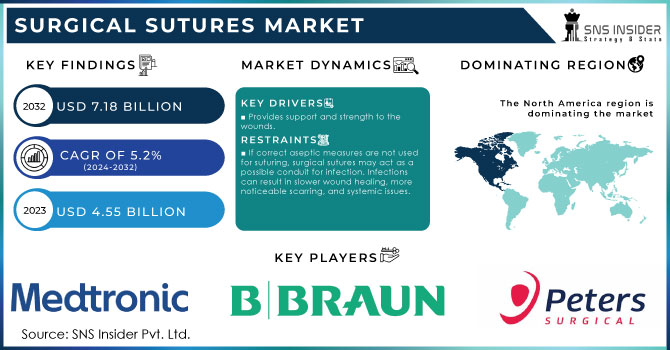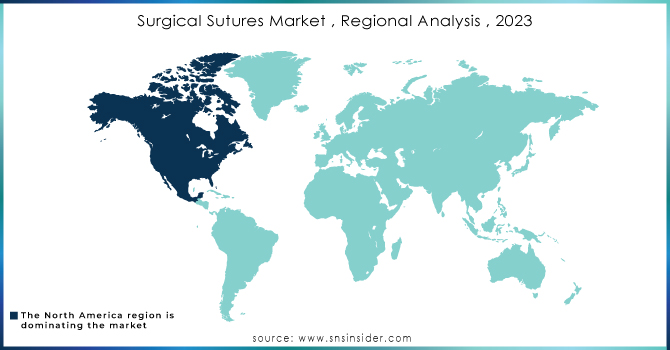Surgical Sutures Market Report Scope & Overview:

Get more information on Surgical Sutures Market - Request Sample Report
The Surgical Sutures Market size was projected at USD 4.55 billion in 2023 and is anticipated to reach USD 7.18 billion by 2032 at a CAGR of 5.2% over the forecast period of 2024-2032.
Medical devices called surgical sutures, commonly referred to as stitches, are used to close wounds or surgical incisions. They are frequently employed during surgical operations to approximate tissues or keep together the borders of a wound. In order to speed up the body's natural healing process and aid in wound healing, sutures are crucial.
Generally speaking, absorbable materials like polyglactin, polyglycolic acid, or polylactic acid, as well as sterile materials like silk, nylon, and polypropylene, are used to create surgical sutures. The type of tissue being sutured, the location of the incision, and the anticipated duration of healing all influence the choice of suture material. Sutures fall into two categories: absorbable and non-absorbable.
Market Dynamics:
Driver
-
Provides support and strength to the wounds.
During the first stage of healing, sutures give the wound support and mechanical strength. By distributing tension evenly across the wound, they lessen the danger of wound disruption and decrease stress on the tissues that are healing.
Restrain
-
If correct aseptic measures are not used for suturing, surgical sutures may act as a possible conduit for infection. Infections can result in slower wound healing, more noticeable scarring, and systemic issues.
Opportunity
-
Sutures with better wound healing capabilities may be the subject of future research and development. Sutures that have been treated with growth hormones or antimicrobials to speed up the healing process and prevent infection are examples of this.
Challenge
-
Although scarring is reduced with the use of sutures, scarring is still a potential side effect of wound healing. The severity and appearance of scarring can be influenced by elements like patient age, the location of the lesion, and genetic susceptibility.
Impact of Russia-Ukraine War:
The availability and distribution of medical supplies, especially surgical sutures, could be indirectly impacted by the conflict if it undermines the broader healthcare infrastructure of either nation. The supply chain and distribution of medical items may be affected by delays in transportation, harm to medical facilities, or resource reallocations to urgent requirements in conflict zones.
Overall, even if the conflict between Russia and Ukraine may have an indirect influence on the distribution and availability of surgical sutures in conflict-affected areas, these medical equipment's worldwide production and supply chains are normally built to resist such disruptions.
Impact of Recession:
To ease financial strains during a recession, healthcare facilities may undertake cost savings initiatives. This may entail negotiating lower pricing with suppliers, moving to less expensive options, or putting policies in place to cut down on waste. Such actions may have an indirect effect on the choice and use of surgical sutures, possibly changing the brands or types that are employed.
Impact on the healthcare workforce: During a downturn, healthcare workers may experience job instability or shortened hours, which can limit the capacity of medical facilities as a whole. Surgery operations and, subsequently, the use of surgical sutures may be affected by labour reductions or other constraints.
Key Market Segmentation
By Product Type
-
Automated Suturing Devices
-
Sutures
By Material
-
Monofilament
-
Multifilament
By Application
-
Cardiovascular Surgeries
-
General Surgeries
-
Orthopedic Surgeries
-
Other Surgeries
Regional Analysis:
North America region will have the highest share because the region has a strong suture manufacturing industry, considerable demand for cutting-edge medical technologies, and a well-established hospital infrastructure. The FDA in the United States and other regulatory agencies control the marketing and approval of surgical sutures.
Europe will be the region with the second largest share because Europe region has strict regulatory criteria that guarantee the performance and safety of medical products, including surgical sutures, such the CE marking in the European Union.

Get Customized Report as per your Business Requirement - Request For Customized Report
Regional Coverage
North America
-
US
-
Canada
-
Mexico
Europe
-
Eastern Europe
-
Poland
-
Romania
-
Hungary
-
Turkey
-
Rest of Eastern Europe
-
-
Western Europe
-
Germany
-
France
-
UK
-
Italy
-
Spain
-
Netherlands
-
Switzerland
-
Austria
-
Rest of Western Europe
-
Asia Pacific
-
China
-
India
-
Japan
-
South Korea
-
Vietnam
-
Singapore
-
Australia
-
Rest of Asia Pacific
Middle East & Africa
-
Middle East
-
UAE
-
Egypt
-
Saudi Arabia
-
Qatar
-
Rest of Middle East
-
-
Africa
-
Nigeria
-
South Africa
-
Rest of Africa
-
Latin America
-
Brazil
-
Argentina
-
Colombia
-
Rest of Latin America
Key Players
The major players are Medtronic Plc, B. Braun Melsungen, Peters Surgical, ConMed Corporation, DemeTECH Corporation, Boston Scientific Corporation, Johnson & Johnson, Healthium MedTech and other players
Recent Developments:
Boston Scientific Corporation : The company has announced the agreement to acquire Apollo Endosurgery.
Healthium MedTech : The company receives US FDA registration for its Sri City manufacturing facility in Andhra Pradesh.
| Report Attributes | Details |
| Market Size in 2023 | US$ 4.55 Bn |
| Market Size by 2032 | US$ 7.18 Bn |
| CAGR | CAGR of 5.2% From 2024 to 2032 |
| Base Year | 2023 |
| Forecast Period | 2024-2032 |
| Historical Data | 2020-2022 |
| Report Scope & Coverage | Market Size, Segments Analysis, Competitive Landscape, Regional Analysis, DROC & SWOT Analysis, Forecast Outlook |
| Key Segments | • By Product Type (Automated Suturing Devices, Sutures) • By Material (Monofilament, Multifilament) • By Application (Cardiovascular Surgeries, General Surgeries, Orthopedic Surgeries, Other Surgeries) |
| Regional Analysis/Coverage | North America (US, Canada, Mexico), Europe (Eastern Europe [Poland, Romania, Hungary, Turkey, Rest of Eastern Europe] Western Europe] Germany, France, UK, Italy, Spain, Netherlands, Switzerland, Austria, Rest of Western Europe]). Asia Pacific (China, India, Japan, South Korea, Vietnam, Singapore, Australia, Rest of Asia Pacific), Middle East & Africa (Middle East [UAE, Egypt, Saudi Arabia, Qatar, Rest of Middle East], Africa [Nigeria, South Africa, Rest of Africa], Latin America (Brazil, Argentina, Colombia Rest of Latin America) |
| Company Profiles | Medtronic Plc, B. Braun Melsungen, Peters Surgical, ConMed Corporation, DemeTECH Corporation, Boston Scientific Corporation, Johnson & Johnson, Healthium MedTech |
| Key Drivers | • Provides support and strength to the wounds. |
| Market Restraints | • If correct aseptic measures are not used for suturing, surgical sutures may act as a possible conduit for infection. Infections can result in slower wound healing, more noticeable scarring, and systemic issues. |

